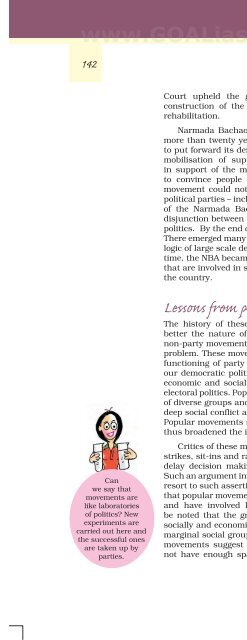t.com www.GOALias.blogspot.com www.GOALias.blogspot.com
t.com www.GOALias.blogspot.com www.GOALias.blogspot.com
t.com www.GOALias.blogspot.com www.GOALias.blogspot.com
- No tags were found...
Create successful ePaper yourself
Turn your PDF publications into a flip-book with our unique Google optimized e-Paper software.
<strong>www</strong>.<strong>GOALias</strong>.<strong>blogspot</strong>.<strong>com</strong>142 Politics in India since IndependenceCourt upheld the government’s decision to go ahead with theconstruction of the dam while also instructing to ensure properrehabilitation.Narmada Bachao Aandolan continued a sustained agitation formore than twenty years. It used every available democratic strategyto put forward its demands. These included appeals to the judiciary,mobilisation of support at the international level, public ralliesin support of the movement and a revival of forms of Satyagrahato convince people about the movement’s position. However, themovement could not garner much support among the mainstreamof the Narmada Bachao Aandolan depicted a gradual process ofdisjunction between political parties and social movements in Indianpolitics. By the end of the ’nineties, however, the NBA was not alone.There emerged many local groups and movements that challenged thelogic of large scale developmental projects in their areas. Around thistime, the NBA became part of a larger alliance of people’s movementsthat are involved in struggles for similar issues in different regions ofthe country.Canwe say thatmovements arelike laboratoriesof politics? Newexperiments arecarried out here andthe successful onesare taken up byparties.Lessons from popular movementsThe history of these popular movements helps us to understandbetter the nature of democratic politics. We have seen that thesenon-party movements are neither sporadic in nature nor are these aproblem. These movements came up to rectify some problems in thefunctioning of party politics and should be seen as integral part ofour democratic politics. They represented new social groups whoseeconomic and social grievances were not redressed in the realm ofelectoral politics. Popular movements ensured effective representationof diverse groups and their demands. This reduced the possibility ofdeep social conflict and disaffection of these groups from democracy.Popular movements suggested new forms of active participation andthus broadened the idea of participation in Indian democracy.Critics of these movements often argue that collective actions likestrikes, sit-ins and rallies disrupt the functioning of the government,delay decision making and destabilise the routines of democracy.Such an argument invites a deeper question: why do these movementsresort to such assertive forms of action? We have seen in this chapterthat popular movements have raised legitimate demands of the peopleand have involved large scale participation of citizens. It shouldbe noted that the groups mobilised by these movements are poor,socially and economically disadvantaged sections of the society frommarginal social groups. The frequency and the methods used by themovements suggest that the routine functioning of democracy didnot have enough space for the voices of these social groups. That
















